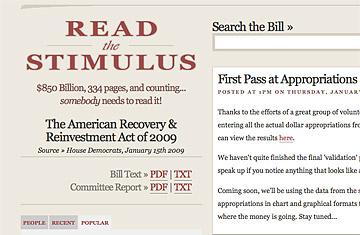
The proposed $825 billion stimulus package currently making its way through Congress will be the most expansive spending plan the government has ever proposed. It's expected to cut taxes, fund everything from highways to college education, extend COBRA health insurance for the unemployed, and...give $150 million to the Smithsonian Institution?
That's what the folks at readthestimulus.org found out, anyway. Spearheaded by conservative think tank The Heritage Foundation, readthestimulus.org allows anyone to read a searchable PDF version of the House of Representatives' stimulus bill (when the Senate version is released, it will also go on the website). But the bill is 334 pages long and growing every day — with amendments and changes, the current version is up to 941 pages. Nobody wants to sit down and read nearly a thousand pages of legislation for fun. That's where readthestimulus.org gets all Web 2.0 on Congress: it's a forum where anyone who wants to can comb through a few pages of the bill and record their findings in a Google document. Volunteers can do as many or as few pages as they like. "We wanted people to know where their money was going," says Rob Bluey, director of online strategy at Heritage. Bluey says that while the government has made PDF versions of bills available online for a while now, the documents are never searchable and they are hard for regular citizens to digest. "The government wasn't doing it, so we stepped in to fill that void." (Read "How to Spend a Trillion Dollars")
The site has only been live for a week and already its 14 volunteers — some are Heritage employees, others work for nonprofits, and still others are just passionate people with extra time on their hands — have finished their first run through of the bill. While readthestimulus.org enters the second, fact-checking phase, some volunteers have taken on side projects of their own. Kristina Rasmussen, director of government affairs at the National Taxpayers Union, has been cross-referencing the federal agencies mentioned in the bill with U.S. Office of Management and Budget's program assessments and has found a number of programs that are receiving money despite poor performance reviews.
So what's actually in this legislative monstrosity? $800 billion goes a long way, and it seems like everyone is getting something. There's $2 billion for renovating public health care centers, $1 billion for the Head Start program, $800 million for Amtrak, $150 million for the Smithsonian Institution, and — wait a second — $14 million for the Accountability and Transparency Board members' travel expenses? There is also a clause that requires all infrastructure projects to be made with U.S. steel, unless it ends up costing 25% more than foreign materials. "Is that the best deal for American taxpayers?" asks Rasmussen, "making people pay more for these infrastructure projects?"
Whatever your thoughts — maybe using American-made materials will create jobs, or maybe it's just another way for Congress to bring home the pork — readthestimulus.org is pleasantly agenda-free. Users can comment on individual bill pages, and while most commenters swing right (renewable energy investments really get people fired up), the project's goal is to simply get the information out there. "The whole project is frankly in some sense stupid," says Rob Neppell, president of new media development company Kithbridge, who runs the website. "It's stupid because we're doing a lot of reengineering, we're trying to actually extract real information out of the text. It shouldn't require a nonprofit company to do the government's work for them."
See TIME's Pictures of the Week